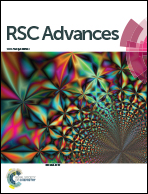Banded spherulite templated three-dimensional interpenetrated nanoporous materials†
Abstract
A “banded spherulite templated” strategy has been developed to fabricate 3-D interpenetrated nanoporous polymeric materials. Poly(oxymethylene) (POM) crystallizes into large banded spherulites with incorporation of poly(L-lactic acid) (PLLA) at high temperature. The amorphous PLLA components are simultaneously expelled out from the twisted POM crystal lamellae during the crystallization of the POM components. Therefore, a fully co-continuous phase structure is formed with the interpenetration of POM twisted lamellae and the amorphous PLLA phase. The nanoporous POM materials with high porosity and large specific surface area were successfully obtained after extracting the PLLA phase between the twisted POM lamellae. The 3-D interconnected nanoporous POM films obtained using this strategy could be used in various applications. Moreover, such a strategy should also be applicable to other polymer blend systems and it provides a new route for fabricating nanoporous polymeric materials.


 Please wait while we load your content...
Please wait while we load your content...